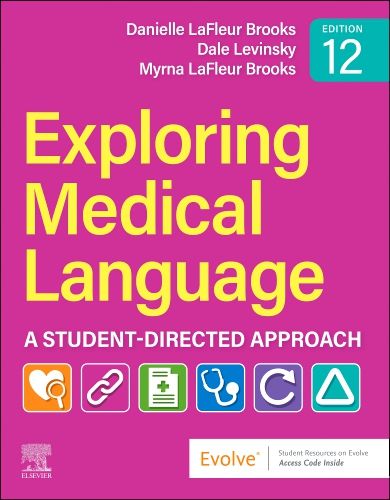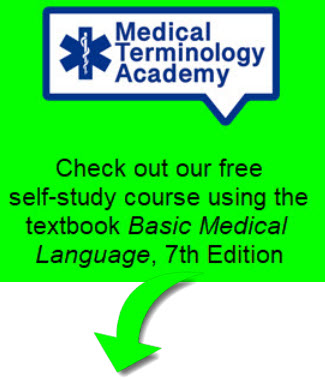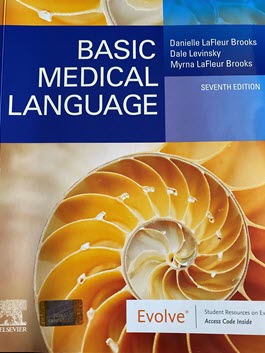(Note: The following tips are aligned with use of the textbooks, “Exploring Medical Language” and “Basic Medical Language” but will be useful for other textbooks as well.)
WHOLE CLASS ACTIVITIES
Beginning the Class – as students walk in the door, assign a term written on the board to analyze and define. Review as a class after taking attendance.
This activity immediately engages students, asking them to demonstrate learning from the assigned chapter, and provides a quick review. It also gives you a chance to greet students as they enter the classroom and to take attendance while they are engaged in an activity.
Pronunciation – pronounce each term in the word list or use the Evolve Resources for Students* website pronunciation exercise to hear the words pronounced then have the students, as a group, repeat them.
This activity gives the students the opportunity to both speak and hear the terms in a non-threatening environment.
Student Presentations — if students have been assigned to conduct a healthcare professional interview or write case studies, schedule them to report their results to the class.
Students practice using terms in context while sharing information about medicine and health care.
Read Medical Terms in Use – project this exercise on the screen from the Evolve Resources for Students* website or from the Evolve Resources for Faculty** website PowerPoint slide. Have the students volunteer to read a sentence aloud until all content is heard.
This activity gives the students an opportunity to pronounce and hear terms in context of medical writings.
Ending the class – ask each student to give voice to their significant learning from the class time. Require everyone to speak. I call this a Lightening Round of Significant Learning, and let students know at the beginning of class that they are responsible for quickly reporting their significant learning for the day to the whole class.
This activity cultivates an equitable classroom environment by giving all time to speak. It also provides an opportunity to move information from short-term memory into long-term memory through the focus of attention required to select and remember significant learning and through the relational aspect of speaking with others.
GROUP ACTIVITIES
Flashcards
- Divide the students into small groups of three or four and give them 5-15 minutes.
- Direct them to use their flashcards to review the word parts for the chapter they are studying by having one person hold the card and the others give the meaning. Smart phones, laptops, or tablets may also be used to access electronic flashcards available on Evolve Resources for Student* website.
- Extend the activity by having students group cards by the types of information they convey, such as anatomic structure, descriptive, pathology, surgery, and diagnostics.
This simple activity can be quick and effective. If done at the beginning of class time the students are reminded of the meaning of the word parts and energized by the activity.
Textbook
- Divide the students into small groups of three or four.
- Assign the groups a textbook chapter exercise to complete in a given amount of time.
- When time is up, ask the students to take turns reading the terms and the definitions aloud and/or if an analyzing exercise have the student use the whiteboard to analyze the terms.
This activity gets students working together and learning from one another while becoming familiar with their textbooks. They also get practice in saying and hearing the terms. Students may be reluctant to pronounce medical terms aloud so to ask the class as a whole to pronounce the term is a good idea.
Reading
- Divide the students into small groups of three or four.
- Assign a medical record, either one from the textbook or Electronic Health Record from the Evolve Resources for Students* website. Project the medical record on a screen or have students use their textbook or devices.
- Direct the students to practice reading the medical document within their group.
- Extend the activity by asking students to conduct informal Internet research on a medical term used in the document by using their phones, laptop, or tablets.
- Have the students take turns reading portions of the document to the class at large and share what they learned through research.
This is such a meaningful exercise. It brings group attention to the application of terms in the workplace and gives practice in saying terms as well as hearing them in use.
Writing
- Divide the students into teams.
- Give each group five terms.
- Instruct them to write sentences using each term.
- Have the students take turns in reading their sentences aloud to the class.
This activity gives the students the opportunity to use the terms in sentence form.
Games
- Divide the students into teams.
- Use any of the electronic games that accompanies your textbook.
- For competition, the winner is the team with the most correct answers.
Games are great for learning and have a place in the classroom. Make them competitive if you choose. A favorite for Basic Medical Language is Medical Millionaire from Evolve Resources for Students* website and two favorites for Exploring Medial Language are Medical Millionaire Evolve Resources for Students* website and Tournament of Terminology available on TEACH in Evolve Resources for Instructors** website. Tournament of Terminology is a good game for review and to prepare students for exams.
*EVOLVE RESOURCES for STUDENTS: Website for Exploring Medical Language and Basic Medical Language including games and exercises that match the textbook content.
**EVOLVE RESOURCES for FACULTY: Website for Exploring Medical Language and Basic Medical Language including lesson plans, power points, handouts, and Tournament of Terminology game.
Warmly,
Danielle LaFleur Brooks, MEd, MA
Allied Health Instructor
Community College of Vermont
danielle.lafleurbrooks@ccv.edu



